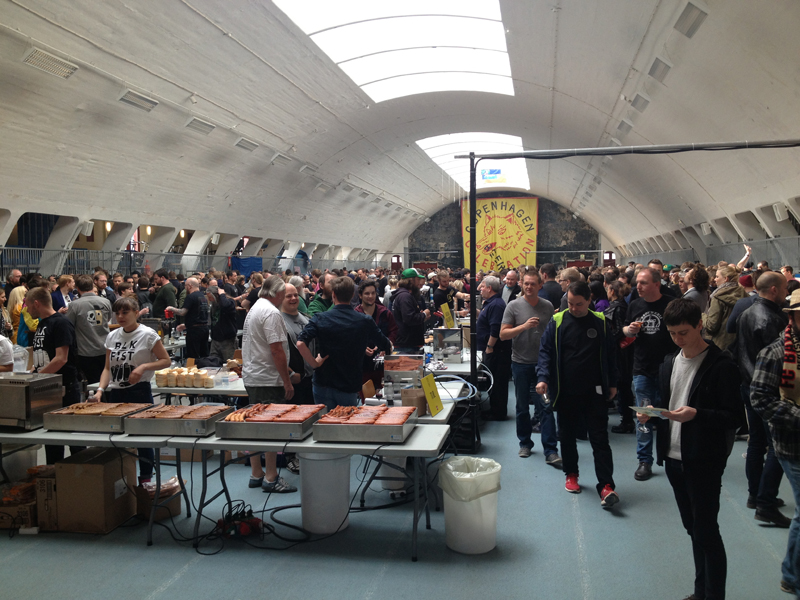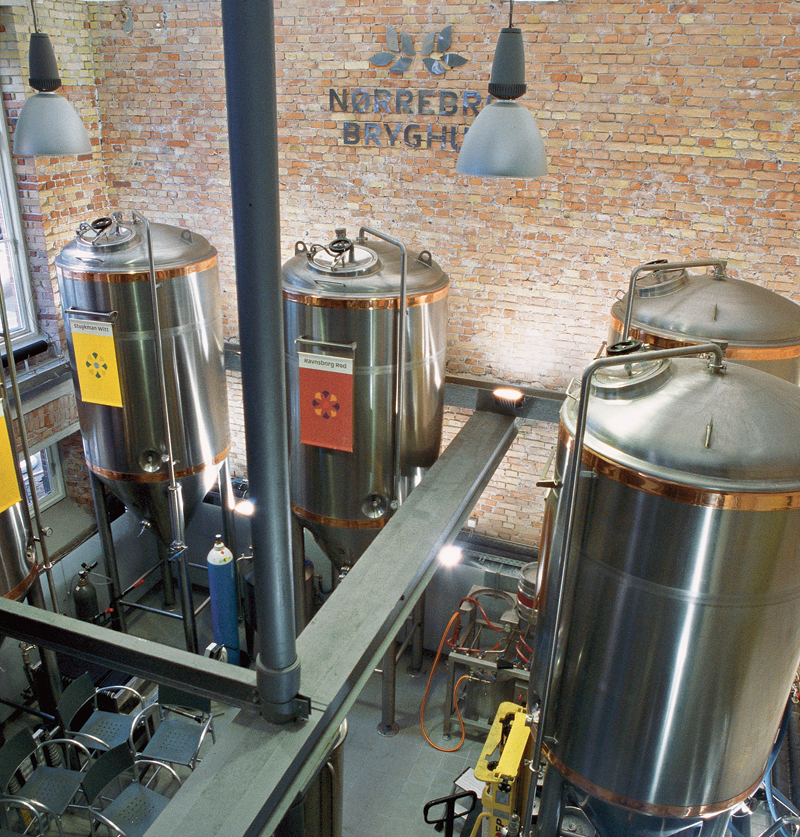Beer Counterpoints: Copenhagen & Oklahoma City
The annual Copenhagen Beer Celebration parades 40 of the world’s top brewers in front of a limited number of dedicated beer geeks, who are in fact the ones who do the marching from brewer to brewer.
The grand marshal is Mikkel Borg Bjergsø, the prominent roving brewer behind Mikkeller, whose brands, it can be said, are the beer equivalent of things people fry at the Texas State Fair (I wouldn’t be surprised if Mikkeller took that fair’s fried beer and turned it into a fried beer-flavored beer). After all, its Beer Geek Brunch Weasel is made with Kopi Luwak coffee brewed after beans pass from head to tail-ish of Asian civets (which resemble weasels).
Truly, even though many beers from Danish brewing companies aren’t brewed in Denmark, it’s the land where anything goes. (Herslev Bryghus makes a white asparagus beer that’s not just oddball, it’s also surprisingly wonderful because of or in spite of its flavor accuracy.) As a counterpoint to Danish envelope
pushers, Oklahoma City is developing a sturdy brewery culture that, like many residents, could be described as salt of the earth.
Copenhagen, Denmark
Consider that the Danes were the first to construct theme parks. The world’s oldest, Bakken, has been in existence for four centuries and is situated just 13 kilometers away from Tivoli Gardens, the 160-year-old Copenhagen attraction that inspired Walt Disney. Unlike the dry Disney parks, Tivoli Gardens has its own brewpub, Færgekroen. So don’t be surprised that Copenhagen is now at the forefront of beer-soaked amusement.
Copenhagen (CPH) is also renowned for its concentration of the world’s foremost beer tickers, folks on a mission to review as many beers as possible. Two of them, Henrik Papsø and Jens Ungstrup, steered me toward the top destinations, beginning with Mikkeller and Friends (Stefansgade 35, next to Nørrebro Park), the newer of Mikkeller’s two hop havens in town. There exist 40 taps split between two bars, many from “friends” such as 3 Floyds, Surly and Italy’s Brewfist, that seem to be for predominantly strong, barrel-fortified beers along with sour or wild ales. There were three from Cantillon during my visit. Best of all, when the weather’s nice they dispense a few beers across the street with tables set up by a large park. Cheers to Europe! A favorite among the Mikkeller beer from my visit was Orange Yuzu Glad I Said Porter, which, sure enough, is a porter with orange and another citrus fruit, the Japanese yuzu, then aged in a Grand Marnier barrel for good measure. The original Mikkeller BAR (Viktoriagade 8, Vesterbro District) provides “only” 20 taps.
CPH’s newest tap house, Taphouse (Lavendelstræde 15, in the City Centre), features 61 thoughtfully selected taps for the full spectrum of drinkers, each selected by Ungstrup. Who was hired for his vast knowledge. it was instantly, reportedly, Europe’s third-largest tap house. With that many taps, I found four Scandinavian-brewed Mosaic-hopped beers proving that European brewers look first to American hop varietals. My personal favorite during a recent visit was dubiously named Smoked Cracow, a Grodziskie that’s a Polish-style smoked wheat beer, my first from an actual Polish brewery, Pracownia Piwa.
As far as brick ’n’ mortar breweries, visit Nørrebro Bryghus (Ryesgade 3, Nørrebro District) in a former metal factory, established by brewmaster Anders Kissmeyer in 2003 after he left Carlsberg. Upon entering,
patrons either walk upstairs or down. Head up to the packed brewpub serving local specialties such as various herrings with rye bread and other artistically presented Smørrebrød, or open-faced sandwiches. Step down for the even more crowded bar with a loud but cozy seating arrangement including some small and some communal tables and sofas in a brightly painted yet dimly lit room somewhat partitioned from the brewhouse. There are several solid if not ground-shaking styles, including a “New York Lager” and Maharaja imperial IPA, like biting into a tangerine with bitter orange peel in finish.
Further proving that not all Danish breweries are gypsies, a kilometer walk away is a small brewery, Ølsnedkeren (Griffenfeldsgade 52). A 300-liter brewhouse is unseen downstairs, meaning the tasting room, frequently packed with CPH’s young, stylish locals, rests above it.
One more great production brewery is Amager Bryghus (Fuglebækvej 2, in the Amager suburb) started by homebrewers Morten Valentin Lundsbak and Jacob Storm in 2007. It makes a wide variety of beers, including Rugporter, a porter made with the quintessential Scandinavian grain, rye, to the Sinner Series, with one for each of the seven deadly sins. Gluttony, appropriately, is a bold 9.5% Imperial IPA.
Another must-hit spot to soak up the local scene is Ørsted (Nørre Farimagsgade 13) across from the Ørstedsparken (Orsted Park). Step down into this pub where the great vibe includes a live DJ spinning sweet tunes at low-enough volume that nobody needs to shout. It’s not cramped, and there are plenty of comfy sofas and chairs, multiple rooms dimly candlelit (with beer-geek-worthy “dead soldiers” as candlesticks). Expect to find 20 highly geeky taps with Scandinavian and American IPAs, barrel-aged numbers and sours.
Finally, Torvehallerne (Frederiksborggade 21), immediately outside the Nørreport Stationmarket hall, features about 60 stalls with amazing butchers, fishmongers and ample opportunities for noshing. My two favorites are Arla Unika, where cheesemakers worked with Mikkeller creating unique cheeses for the festival, including one smoked over hops and one imbued with Simcoe vodka, and Omegn, with a small but mighty assortment of cured meats, interesting cheeses as well as beer bottles. Here you’ll find Bøgedal
Bryghus, a truly farmhouse brewery that focuses on traditional lys ales, each named only after the batch numbers. Proprietary Bøgedal #396, a.k.a. Bøgedal Omegn-2, is made with barley grown on the brewer’s farm, illustrating how here, even historic methods can be progressive/modern/distinctive.
Day Trip: Malmö, Sweden
A quick train ride lands you in another country, and after years of Swedes riding it to buy up all the Danish beer, now they’re making their own. There are three breweries in the border city of Malmö. The elder statesman is Malmö Brygghus residing in an operating chocolate factory, hence the amazing Cacao Porter that’s desserty and lusciously silky like a Lindt chocolate truffle. But the Saison la Charrue’s graininess, reminiscent of bird seeds, complements the buns of its American-style pub sandwiches that come with fries (served with mayo, since it’s Europe). The new-school brewery, Brekeriet (22 Djurslövsvägen), purveys generally Belgian-style and sour ales. I missed getting to visit the brewery, but sales manager Fredrik Ek (one of three Ek brother owners) tipped me off where I could find its beers around Malmö. På Besök (Nobelvägen 73) is a small place with 10 taps, but its eye-level beer cellar contains Brekeriet Cassis 2012 batch (and Mikkeller’s Cognac-aged Beer Geek Brunch Weasel). The cassis with two years on it becomes much drier and sourer with a red-orange hue. Grab dinner at Sömer Om Småland (Claesgatan 8), but there’s no sign (the fact that it’s across the street from Abel’s Rehab might be a bad sign). A hip, sexy crowd sits at white tables with wagon wheels and wooden posts—spikes really, because Scandinavia—overhead. For dessert, I had Hoptimus Erectus IPA from Malmö’s third brewery, South Plains because I needed something to accentuate the hops in the chocolate truffle rolled in Citra hop brittle. Ja!
Brian Yaeger
Brian Yaeger is the author of Oregon Breweries and Red, White, and Brew: An American Beer Odyssey.




Leave a Reply